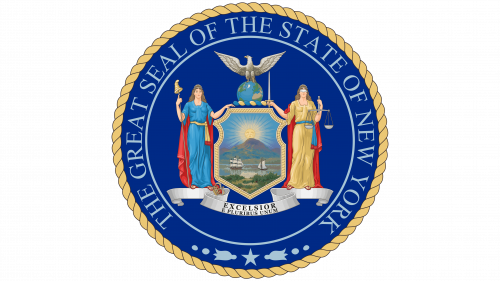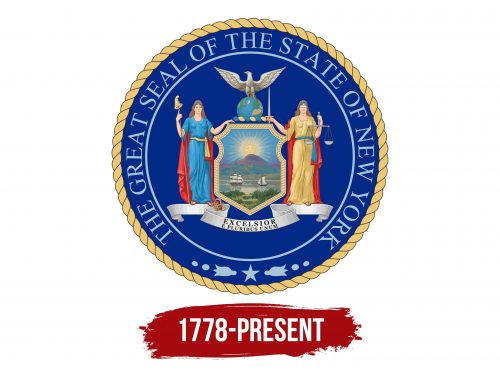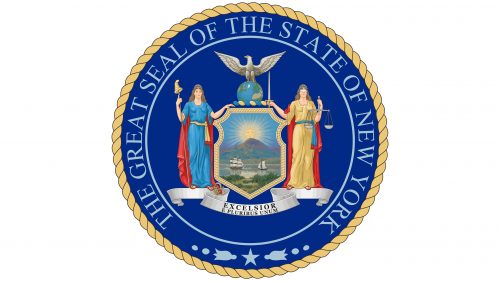New York’s emblem includes many subtle but historically significant elements, each of which tells the story of the most important events in the formation and development of the state. The emblem conveys a close connection to America and its ideals.
New York: Brand overview
New York is a state on the east coast of the United States, washed by the Atlantic Ocean and covering an area of about 141 square kilometers. The state is home to more than 20 million people in 62 counties comprising 933 cities. The state capital is the city of Albany.
Meaning and History
The coat of arms served as the seal of the state of New York and was used as a great seal. It was designed by a special commission appointed in 1880. It was based on the image present on banners during the Revolution of 1775, and in 1778, it was officially adopted as the state’s symbol. It was exclusively the rising sun over the mountains and the motto. A commission added the rest of the details, and in 1882, the state assembly officially established the coat of arms. Fourteen years later, minor changes were made to the symbol, which has remained unchanged ever since.
What is New York?
It is an American state with 40% of its residents living in one of six major cities, New York City. Only 15% of New Yorkers live in rural areas. The state thrives on banking and real estate. Despite its American jurisdiction, only 70% of New Yorkers speak English, emphasizing its welcoming attitude toward immigrants.
1778 – today
The coat of arms is in the form of a circle framed by intertwined cords. The border symbolizes unity, the state’s incorporation into the United States, and the intertwining of liberty and justice that maintains order. The intertwined cords allude to land transactions between natives and settlers. The framing also indicates that the state is home to people from different countries.
Along the inner edge of the circle is an inscription indicating the purpose of the emblem: Great Seal of the State of New York.
In the center, between the beginning and end of the inscription, a star and two lilies are directed in opposite directions.
In the center is a shield with the image of a sloop and a sailing ship moving on the water against a background of mountains. Given the state’s proximity to the water, the ships symbolize foreign and domestic trade. The river depicted is believed to be the Hudson River flowing through New York City. The rising sun pays homage to the Duke of York, after whom the state and city were named. The celestial body symbolized his lineage.
Two goddesses support the heraldic shield on either side.
- Liberty is the Roman goddess Libertas. She is dressed in a blue chiton. In her hands, she holds a rod with a Phrygian cap, the forerunner of the pileus cap. This meant that freed slaves of ancient Rome wore headdresses. Over time, the more modern Phrygian cap replaced it in depictions of the goddess. On seals, the cap often replaces the image of the monarch’s crown, denoting republican rule. In this context, it emphasizes the right of the people to be free from tyranny. On seals, Libertas steps on the British crown, symbolizing the liberation of the colonies from England.
- Justice is the Greek Themis or the Roman Iustitia. She is dressed in a golden chiton. Her eyes are blindfolded, symbolizing impartiality. In one hand, she holds a scale, symbolizing the weighing of good and evil deeds. In the context of the state, this signifies the equality of all before the law. On the other hand, Themis holds a punishing sword.
The figures embody the founding principles of all state and U.S. laws. Interestingly, both statues look like exact replicas of each other. They had identical faces, flowing hair, pearl tiaras, red sandals, and red cloaks. Such an image indicates equivalence and equal importance of the principles.
Above the shield is a burlet, a border of gold and blue cords symbolizing the intertwining of Liberty and Justice. On it rests the globe. Interestingly, the globe depicts both sides of the Atlantic Ocean, North America, and Europe, which have historically intertwined with each other. Dutch colonists were the first to settle on the lands of the state. Subsequently, the English ruled these territories for a long time. The discovery and settlement of America is also a merit of Europe.
At the top of the globe sits an eagle with outstretched wings and looks to the right. The bird is a symbol of America, under whose jurisdiction the state is located. The outstretched wings signify protection, and the head turned to the right alludes to the country’s coat of arms, where the eagle faces an olive branch as a sign of peace. This image suggests that America provides peace and prosperity to the nations in its union.
Liberty and Justice stand on a heraldic ribbon inscribed “Excelsior,” conveying the theme of the rise and flourishing of the state. In 2020, the inscription “E Pluribus Unum” (“Out of Many, One”) was added to the motto of the United States, indicating the formation of the country from the states.
Font and Colors
The dominant colors of the emblem are blue and gold. Blue symbolizes the blue waters of the rivers and oceans surrounding the state and represents freedom. Gold symbolizes the wealth achieved through fair and equal treatment of all residents and free trade. The shadow speaks of the Sun in the heraldry of the man after whom the city was named.
The inscription is in confident capital letters with serifs, emphasizing the importance of the state and the significance of the seal.





